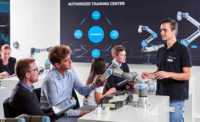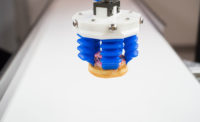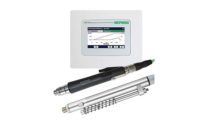Whether you’re chopping vegetables for soup, pruning a tree in the back yard, or filleting a freshly caught fish during a camping trip, a sharp blade is vital for efficiency, quality and safety.
Based in Ashland, OR, Work Sharp Tools has been making sharpeners for kitchen knives, hunting knives, pruning shears, scissors, axes and other bladed tools since 1973. Work Sharp began as Darex in Beecher, IL, making equipment to sharpen industrial cutting tools. The D, A and R of Darex are the initials of three generations of the Bernard family. Grandfather Arthur Bernard, who earlier founded the Bernard Welding Co., contributed his energy and guidance to son Richard and grandson David.
In 1978, Darex relocated to Ashland, where it continues to reside. In 2012, Matthew Bernard became the fourth generation family owner of the company. In December 2020, the company sold the Darex industrial brand and began doing business as Work Sharp, focusing exclusively on the consumer market.
To meet increased demand, the company needed to add more products to its lines without hiring more people.
“Basically, I needed to do more with the same amount of resources,” says John Griffin, director of operations at Work Sharp, explaining that the Ashland area is experiencing a shortage of available workers.
Work Sharp also needed equipment that wouldn’t need a new dedicated space. “We have a small production area, so I wanted something that wouldn’t require a separate cell but would fit right into our assembly line,” says Griffin.
On the assembly line, Griffin wanted to automate the process of installing screws in the plastic housing of a knife sharpener. And, at the packing station, Griffin wanted to automate the process of erecting boxes. For erecting boxes, the company considered using box constructors.
“But they were limited in what they would do and only work on a certain range of boxes. We wanted more flexibility,” says Griffin.
Enter Cobots
Griffin had seen Universal Robots at many trade shows. “They appeared to be simple to program, and even vendors who weren’t selling robotics were using these robots in their booths,” he recalls. “So that kind of told me, ‘Wow, this really is the most popular one.’”
One of the reasons for the cobots’ widespread use is their built-in safety mechanisms that automatically stop the cobot arm when it encounters obstacles in its route. Once a risk assessment is performed, the cobots can then operate without safety caging. “Now I can have people work right next to the cobots without a bunch of caging,” says Griffin.
Not having to spend resources on expensive and cumbersome safety guarding also helped make the collaborative robots attractive in terms of price. “For the ROI on purchasing the cobots, I initially predicted it would take about 16 months,” says Griffin, who was surprised as he saw the UR cobots pay for themselves in less than a year. “We’re running about 30 percent more efficient. I have more flexibility, since it takes less staff to run that line, so I can focus people into different areas and run different products.”
Instead of building only two products a week, Work Sharp can now build four products per week.
The task of assembling the knife sharpeners seemed like a logical place for Work Sharp to start an automation project.
“Traditionally we would have an operator with a pneumatic screw gun retrieving a screw from a screw presenter, sticking it into the machine, and driving it to torque—very monotonous, very ergonomically unfriendly work,” says Griffin.
To alleviate the operators from this undesirable task, Work Sharp chose the UR3 tabletop cobot. The company was able to keep the same setup with the screw presenter and the screw gun; the only thing that differed was that the cobot was doing the task.
Sam Jacobson, production engineering supervisor at Work Sharp, recounts how operators would sometimes miss screw insertions as the holes in the housings were hard to see into. “The UR3 hits all the screws all the time and if not, it will immediately notify us,” he says. “We have definitely seen an increase in product quality due to the cobots.”
The success of the screwdriving application quickly spurred Work Sharp to look at its whole assembly line setup in a new light.
“Since our first application went so smoothly, we decided to up the ante and add a conveyor system and all the PLCs controlling things like the pneumatic press and add another UR robot on the boxing side of it,” says Jacobson. “I actually decided to use the UR controller to program and handle the entire line, using Modbus communication to connect the different PLCs through the UR cobot’s teach pendant. I could program that entire thing so quickly, I was really happy with that decision.”
Folding boxes into shape and packing them with products was another unpopular, ergonomically unfriendly task at Work Sharp. Universal Robots’ midsized cobot, the UR5, took over and is now handling the entire process. The cycle starts with the cobot grabbing a box out of a cassette and folding it into shape. It places the folded box on a staging platform, grabs four individual cartons arriving on the conveyor, and loads them in the box. When the box is full, the cobot closes the lid and pushes the box through the taping station.
Getting Buy-In
Each vacuum unit can be attached to two extraction torches, so Aebi Schmidt employees can weld safely at 26 workstations simultaneously. Each vacuum system is matched to the torch, so welding fumes are optimally captured without destroying the protective gas envelope. Unlike extraction arms placed over or adjacent to the weld area, the extraction system is integrated in the torch, so welders carry it wherever they’re working. The system removes hazardous substances at the point of origin via an extraction nozzle in the torch. Even at high welding intensity, the VacuFil units extract high levels of smoke and dust in continuous operation, with a maximum output of 250 cubic meters per hour, without any loss of quality, even when two employees are welding at the same time.
Equipped with special KemTex ePTFE filter cartridges with surface filtration, the systems permanently filter out more than 99.9 percent of welding smoke particles. Even particles smaller than 0.1 micron have no chance of escaping back into the hall air after extraction.
A welcome feature of the VacuFil system is automatic filter cleaning. Welders do not have to interrupt their work to clean the system’s filter. Instead, as the filter becomes saturated, the hazardous substances enter a special disposable container inside the system. The containers can be changed without exposing workers to the contaminants.
When Work Sharp initially bought the cobots, Griffin was trying to think of ways to get the production team excited about having a robot amongst them. He also needed a dedicated staff member on the line to be the robot technician who could oversee all robot operations. “So I came up with this little competition,” says Griffin. “I gave everybody the UR Academy web address, told them to study up on this and invited them to compete for the job, using the knowledge from the Academy.”
The UR Academy consists of nine interactive, online modules that cover the basic UR cobot programming and setup. Work Sharp held several rounds of contests in which employees were required to program the cobots. The winner was 26-year-old Brittany Mohrman.
“It was really exciting to get the opportunity to do something different, so I jumped right in, learned all I could, aiming to beat out the competition,” she says. “The UR training taught me things like understanding different program cycles, adjusting waypoint changes, and knowing where the tool center point of gravity on the robot is. My job is definitely more interesting now.”
The next task Work Sharp is looking to automate is palletizing boxes as they exit the tape-sealing station.
“Many of our products and boxes are similar in size and shape, so it seems like that would be a good next application,” says Griffin. “It would also keep our employees from having to reach and bend over all the time. Looking at the assembly line we’ve already created, we could also easily take that and replicate it two or three more times in our production area and accomplish the same thing with other products.”
To see a video of the Work Sharp application, click here.
For more information on collaborative robots, click www.universal-robots.com.









